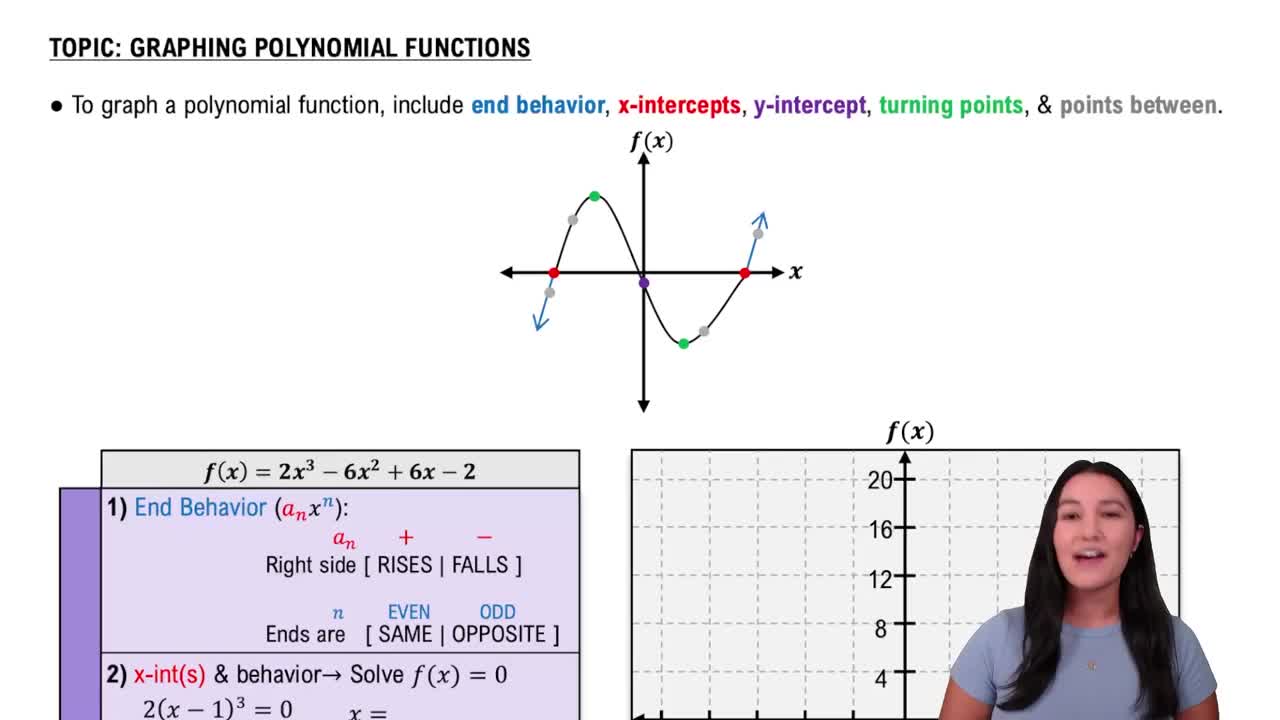Table of contents
- 0. Review of Algebra4h 16m
- 1. Equations & Inequalities3h 18m
- 2. Graphs of Equations43m
- 3. Functions2h 17m
- 4. Polynomial Functions1h 44m
- 5. Rational Functions1h 23m
- 6. Exponential & Logarithmic Functions2h 28m
- 7. Systems of Equations & Matrices4h 6m
- 8. Conic Sections2h 23m
- 9. Sequences, Series, & Induction1h 19m
- 10. Combinatorics & Probability1h 45m
1. Equations & Inequalities
Linear Inequalities
Problem 69f
Textbook Question
Solve each inequality in Exercises 65–70 and graph the solution set on a real number line. (x^2 -x - 2)/(x^2 - 4x + 3) > 0
 Verified step by step guidance
Verified step by step guidance1
<b>Step 1:</b> Factor both the numerator and the denominator of the rational expression. The numerator \(x^2 - x - 2\) factors to \((x - 2)(x + 1)\), and the denominator \(x^2 - 4x + 3\) factors to \((x - 3)(x - 1)\).
<b>Step 2:</b> Identify the critical points by setting each factor equal to zero. The critical points are \(x = 2, -1, 3,\) and \(1\).
<b>Step 3:</b> Use the critical points to divide the number line into intervals: \((-\infty, -1)\), \((-1, 1)\), \((1, 2)\), \((2, 3)\), and \((3, \infty)\).
<b>Step 4:</b> Choose a test point from each interval and substitute it into the factored inequality \((x - 2)(x + 1)/(x - 3)(x - 1) > 0\) to determine the sign of the expression in each interval.
<b>Step 5:</b> Based on the signs from the test points, determine which intervals satisfy the inequality. Remember to exclude any points where the denominator is zero, as these are not in the domain of the original expression.
Recommended similar problem, with video answer:
 Verified Solution
Verified SolutionThis video solution was recommended by our tutors as helpful for the problem above
Video duration:
11mPlay a video:
Was this helpful?
Key Concepts
Here are the essential concepts you must grasp in order to answer the question correctly.
Inequalities
Inequalities express a relationship where one side is not equal to the other, often using symbols like '>', '<', '≥', or '≤'. In this context, solving an inequality involves finding the values of the variable that make the inequality true. Understanding how to manipulate and solve inequalities is crucial for determining the solution set.
Recommended video:

Linear Inequalities
Rational Functions
A rational function is a ratio of two polynomials. In the given inequality, the expression (x^2 - x - 2)/(x^2 - 4x + 3) is a rational function. Analyzing rational functions involves identifying their zeros and undefined points, which are essential for determining where the function is positive or negative.
Recommended video:

Intro to Rational Functions
Graphing Solution Sets
Graphing solution sets on a real number line visually represents the values that satisfy the inequality. This involves marking intervals based on the critical points derived from the rational function's zeros and undefined points. Understanding how to interpret and graph these intervals is key to conveying the solution effectively.
Recommended video:

Graphing Polynomial Functions
Related Videos
Related Practice













